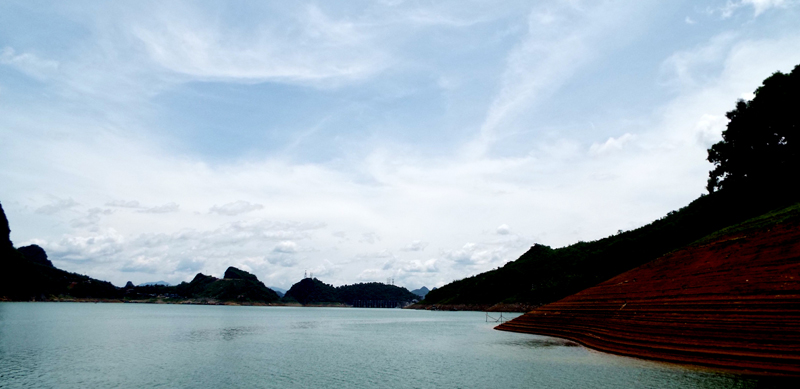(HBO) –Owning beautiful landscape with green mountains and forests as well as diverse cultural colours, the Hoa Binh Lake Tourism Area has become a popular tourist destination, attracting a large number of both Vietnamese and foreign tourists.
HoaBinh
Lake was formed after the construction of the Hoa Binh
Hydropower Plant. It is
Vietnam's
largest lake with a length of more than 100km and a capacity of nearly 9.5
billioncu.m, spanning the districts of Cao Phong, Tan Lac, Mai Chau, Da Bac and
HoaBinhcity. The lake is home to 47 islands of different sizes, including 11
limestone islands covering
116
hectares, and 36 earth islands with total area of
157.5 hectares.
Currently, many islands have been developed into
attractive eco-tourism attractions such as Dua and Xanh islands and Coi Xay Gio
guesthouse. Dua island is the current most popular destination, luring a large
number of tourists thanks to the uniqueness of the stilt houses built with the
Muong ethnic minority group’s traditional architecture, and special tourist
activities such as fishing, fruit picking, boating and camp-firing. Visitors
also have a chance to enjoy local dishes and Da River fish.
Before coming to the Hoa Binh Lake Tourism Area,
tourists can visit the Hoa Binh Hydropower Plant –a work of the 20thcentury
that was built from 1979 to 1994 with eight turbines units having total
capacity of 1,920 MW. This is an important industrial project of
Vietnam as well
as an attractive tourist attraction. Visitors can go down to the tunnel of the
plant to see its turbines and traditional house where a century message that
the predecessors sent to the next generations is being kept. They will also
contemplate the spectacular scene of the plant’s spillway, and offer incense to
President Ho Chi Minh at his 18m-high statue on the Tuong hill where they have
an impressive panoramic view of Hoa Binh city.
Every year, on the occasion of the early spring,
the Bo Temple Festival is held from the seventh day of the first lunar month to
the end of the third lunar month in
Hoa
Binh
Lakearea. Visitors will experience the Mother Goddess Worshipping, a unique
cultural activity of locals, which is also a popular spiritual cultural tourism
site.
The Hoa Binh Lake Tourism Area is also home to
pristine karst caves such as Thac Bo and Hoa Tien caverns which were named
national relic sites by the Ministry of Culture, Sports and Tourism. While
inside the caverns are stalactites in various shapes, in the outside of their
mouths, tourists can stretch their vision to admire the nature’s masterpieces
on the lake’s green water surface with imposing mountains.
In May 2017, the biggest floating water park in
Vietnam was inaugurated in Ngoi
village of
NgoiHoa commune, Tan Lac district,
offering 34 groups of games with floating structures. Once visiting this place,
tourists can experience water sports such as jetski, sailing inflatable boat,
canoeing, kayaking, rafting and fishing which suit people of all ages.
The most interesting are community-based tourist
sites of Muong ethnic minority people in Ngoi
villageof
Ngoi Hoa commune, Ke
village of
Hien Luongcommune, and Da Bia and Mo Hem villages of Tien Phong commune, which are
associated with eco-tourism activities on
Hoa
Binh
Lake and natural landscapes. It will be
a fascinating experience for those who love trekking, visiting villages,
exploring untouched caves or joining local farmers in netting and feeding the
fish.
Due to the potential tourism resources, the
Prime Minister signed Decision 1528/QD-TTg on August 1, 2016, approving an
overall planning on the development of the Hoa Binh Lake National Tourism Area
until 2030. The planning is an important orientation for Hoa Binh province to
call for investment in tourism development and gradually meet the criteria of a
national tourism area, the biggest tourism centre of the province and one of
the 12 key national tourist sites of the northern midland and mountainous
region. The unique tourism values imbued with cultural identities of Hoa Binh
ethnic groups will give tourists unforgettable impressions of the Hoa Binh Lake
Tourism Area.
Luu Huy Linh (Department of Culture, Sports and
Tourism)



